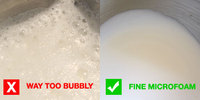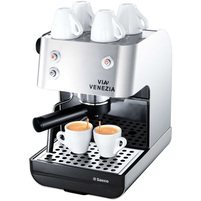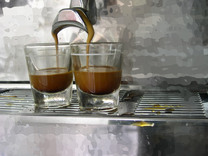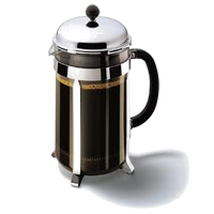Want to know the secret to silky smooth milk?

Do you remember that sound of milk being frothed by some actor on TV? Its sounds a lot like "Pssshhhht...Pssshhhht...Pssshhhht..." as they plung the tip of the steam wand in and out of the milk pitcher. That same motion can be seen at most non-cafe restaurants as they prepare their milk pitcher of milk for your flat white. The problem with all that plunging and action, is that you end up with a very bubbly and soap-suds like consistency to your milk. It ends up being very thick on top from bubbles, and very thin and watery underneath. When you addd that to you your espresso base, you end up with what I like to refer to as a thin cup of coffee.
The secret to producing great microfoam, which is realy what you want, lots and lots of tiny bubbles all through your milk, making a thick and silky smooth texture is to "steam the milk with the tip only gently breaking the surface until the milik gets to 30c (close to body temp by touch), and then to plunge the steam wans INTO the milk pitcher, and if you can, try to make a whirlpool effect" (be careful not to make too much of a whirlpool, or you risk sucking in more air, creating that Pssshhhht...Pssshhhht... noise and fluffing up your milk too much).
At first attempt, it may not seem like this method will work, but it will, and with a little practice, you will be producing delicious silky smooth milk to pour into your coffee base. When you pour microfoam, you will instantly notice a difference in the pour, and the sound of the pour - it appears thicker, and more consistently textured.
Let me know what you think in the comments or if this method has helped you.
Leave a comment below and let me know your single best tip.
Show us your gear on Facebook.

Leave a comment below and let us know the coffee setup you have at home or work.
Pressurised baskets - coffee technique.

Steve asked the question about the impact of a pressurised coffee basket in his new coffee machine, and if he should change it to a after-market non-pressurised basket, improve his coffee.
Here is my reply;
Hi Steve.
Thanks for your email.
You have nailed it - the point that is letting you down is the pressurised basket. Let me first explain why some coffee machine manufacturers use presurised baskets in the first place, and the difference between non-pressurised coffee baskets.
A pressurised basket is different to a non pressurised basket by having only one single hole in the bottom of the basket, vs many holes in a normal basket. The idea is to force the coffee through the one tiny hole, and in the process, creating a fake crema. Thats perfect for the machine manufacturer, becasue even with stale supermarket beans, they can say "look how good the crema is from our machine", but it will lack taste - its just micro-foamed coffee.
Using fresh roasted beans will improve the flavour of your coffee, but the basket being pressurised means that you dont get any good feedback on what is really happening with your coffee extraction.
Breville make non pressurised baskets for their Cafe Roma boiler machine - the machine retails for about $80, but the spare bpart can be ordered seerately for under $10. if it fits your machine, thats what I reccomend as a solution.
When you pay more for a machine, really all you are getting other than facy looks, is a more stable and consistent tempreture and pressure, and better heatup times, which while important, is not absolutely necessary. You will get a much better benefit by changing your basket to a non pressurised basket, and using a coffee tamp. then you can experiment with technique to perfect your coffee.
your aiming for 30ml of coffee in the cup, over 25seconds. If you get more than 30ml, your grind is too coarse, or your tamp too light. I like to try and keep as many things consistent, ie;
30 ml of coffee (per shot)
7grams of coffee (per shot)
25 seconds extraction
15kg of tamp pressure (try using bathroom scales to get an idea of what 15kg of pressure feels like.
I also like to always use a double basket, per coffee extraction, into one cup (so 14g of coffee and 60ml).
Let me know how you get on.
Leave a comment below if you have a question you would like answered.
Coffee and Caffeine linked to lower skin cancer rates.

The study of almost 115,000 men and women found those who drank three or more cups of coffee a day had a 20 percent lower risk of basal cell carcinoma than those who said no to coffee.
"I think we're seeing more and more evidence for the beneficial effects of coffee consumption," said study author Jiali Han, associate professor of dermatology and epidemiology at Boston's Brigham and Women's Hospital and Harvard School of Public Health, explaining that java has also been linked to a reduced risk of diabetes and Parkinson's disease. "I wouldn't recommend drinking coffee solely based on this work, but it does add one more thing to the list."
The study, published today in the journal Cancer Research, sheds new light on a skin cancer that affects 2.8 million Americans each year, and with Australia having a higher incidence of skin cancer, its a great discovery. You can read the entire article here.
Leave a comment below and let us know what you think.
How to make great Plunger coffee

All you need, is a plunger and some fresh roasted coffee beans - you dont even need a grinder, since you can buy your coffee beans pre-ground in the store. Simply add two table spoons of coffee to the plunger, add hot water and give it all a gentle stir. I like to then put the lid on, and then wrap the plunger in a towel, to act as an insulation, keeping your coffee hot. Allow five minutes to brew and then plunge your coffee and pour into a cup. I usually pre-warm the coffee cup with hot water from the kettle, at the same time as I pour water into the plunger.
When I make plunger coffee, the way I like to prepare it is;
1. pre heat the plunger with warm (not boiling) water. This allows the plunger to come upto tempreture and reduces the risk of fracturing with boilng watrer. its also great for improving the tempreture of the final product.
2. empty the water after a few minutes, and dry the plunger
3. add enough coffee for your needs. I use one tablespoon per 300ml of water, plus one extra. So, if your making 600ml, use three tablespoons of coffee
4. pour hot water into the plunger
5. stir the coffee to wet all the coffee grinds.
6. put the lid on, but do not plunge
7. (optional) wrap the plunger in a cloth to keep the brewing coffee warm.
8. wait 5mins, then plunge, slowly - taking around 20 seconds to plunge. Too fast and coffee grinds will seep past most filters.
9. wait 2 mins for the coffee to settle
10. pour slowly into cups
11. enjoy!
Leave a comment below, let us know if a plunger would work for you at work?
A sneaky free giveaway

What is the cost of delivery for 1kg of Bay Beans coffee, delivered to Darwin, Northern Territory?
A) $12.50
B) $19.50
C) Bay Beans doesnt deliver to Northern Territory
D) Delivery is Free, anywhere in Australia, including Northern Territory.
The winner will be randomly selected from the comments below at 5pm Monday 9th, so everyone has a chance to win. Winner will be announced here Monday. (I will also contact the winner directly).
Leave your answer in the comments below AND let me know your favorite coffee bean variety for your chance to win 1kg of Premium Reserve coffee
 RSS Feed
RSS Feed
